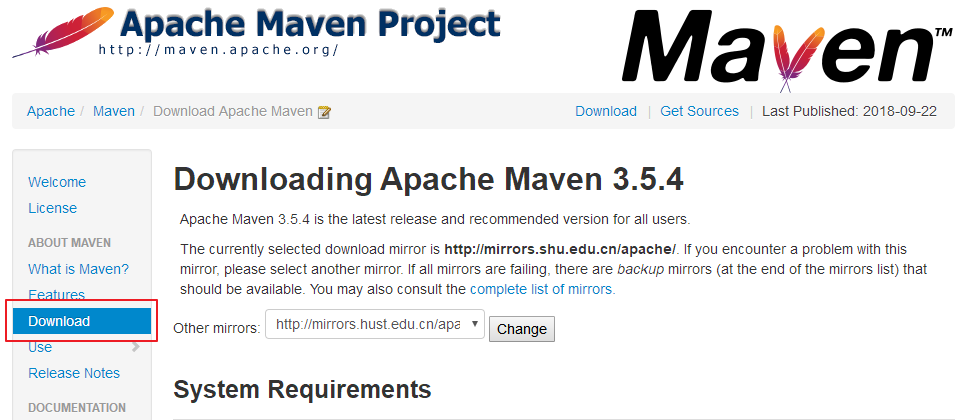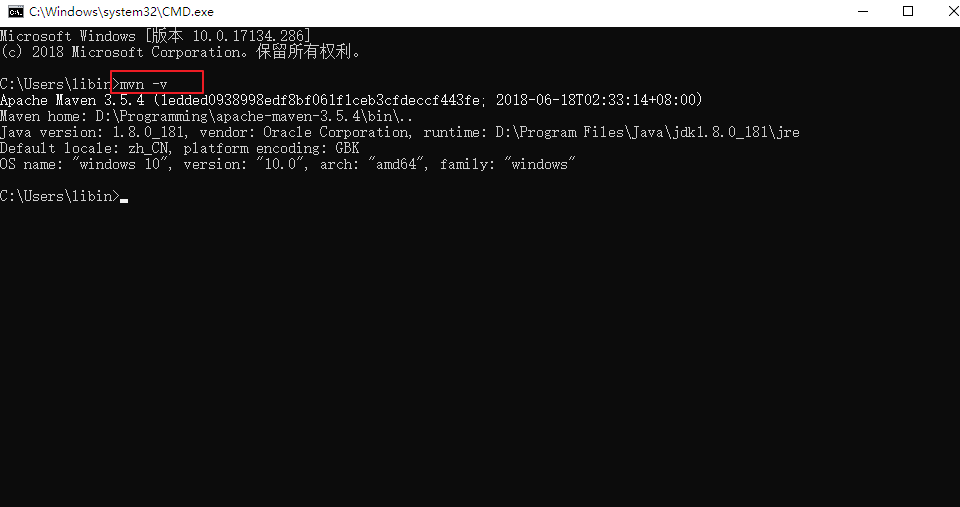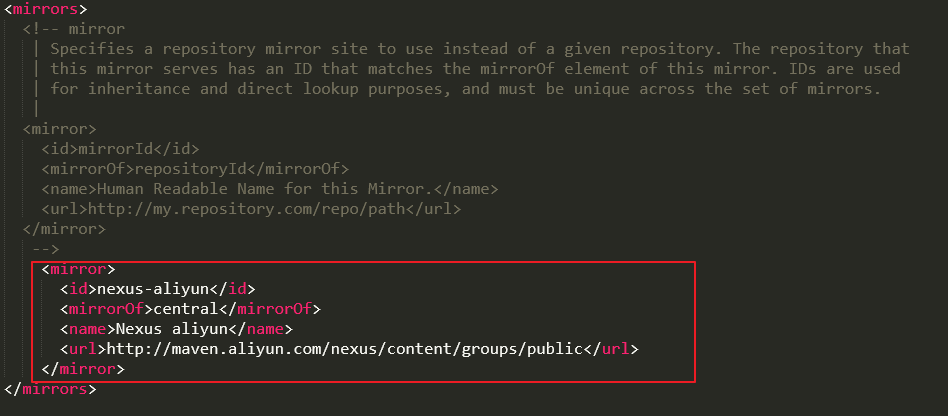Maven下载安装步骤
Maven下载安装步骤
1、下载maven
进入Maven官网的下载页面:http://maven.apache.org/download.cgi,如下图所示:

选择当前最新版本:"apache-maven-3.5.4-bin.zip",下载到本地,解压缩到本地磁盘下。


2、配置
2.1 环境变量的配置



2.2 修改默认的本地仓库位置
进入Maven安装目录下的conf子目录中,打开settings.xml进行配置修改。



<!-- localRepository
| The path to the local repository maven will use to store artifacts.
|
| Default: ${user.home}/.m2/repository
<localRepository>/path/to/local/repo</localRepository>
-->
<localRepository>E:/Maven/repository</localRepository>
Maven默认的本地仓库位置是当前用户工作目录下的".m2/repository",使用过程中这个目录里的文件会比较多,占用空间越来越大。一般建议更换到其它磁盘目录下。如下配置,就把默认的本地仓库更改到自己创建的目录。
如下图所示的localRepository标签中设置,就把默认的本地仓库更改到E:\Maven\repository这个目录(这个目录结构需要自己创建好)。

保存所做的修改,同时还需要把这个settings.xml文件复制一份到“E:\Maven\repository”目录下。

2.3 修改默认的中央仓库镜像
Maven默认的中央仓库里的文件不全。所以,都需要自行添加其它的镜像地址。在settings.xml文件中的“”标签里添加如下内容:

这里的url也可以是:
<mirror>
<id>nexus-aliyun</id>
<mirrorOf>central</mirrorOf>
<name>Nexus aliyun</name>
<url>http://maven.aliyun.com/nexus/content/groups/public</url>
</mirror>
附录settings.xml文件内容如下:
<?xml version="1.0" encoding="UTF-8"?>
<!--
Licensed to the Apache Software Foundation (ASF) under one
or more contributor license agreements. See the NOTICE file
distributed with this work for additional information
regarding copyright ownership. The ASF licenses this file
to you under the Apache License, Version 2.0 (the
"License"); you may not use this file except in compliance
with the License. You may obtain a copy of the License at
http://www.apache.org/licenses/LICENSE-2.0
Unless required by applicable law or agreed to in writing,
software distributed under the License is distributed on an
"AS IS" BASIS, WITHOUT WARRANTIES OR CONDITIONS OF ANY
KIND, either express or implied. See the License for the
specific language governing permissions and limitations
under the License.
-->
<!--
| This is the configuration file for Maven. It can be specified at two levels:
|
| 1. User Level. This settings.xml file provides configuration for a single user,
| and is normally provided in ${user.home}/.m2/settings.xml.
|
| NOTE: This location can be overridden with the CLI option:
|
| -s /path/to/user/settings.xml
|
| 2. Global Level. This settings.xml file provides configuration for all Maven
| users on a machine (assuming they're all using the same Maven
| installation). It's normally provided in
| ${maven.conf}/settings.xml.
|
| NOTE: This location can be overridden with the CLI option:
|
| -gs /path/to/global/settings.xml
|
| The sections in this sample file are intended to give you a running start at
| getting the most out of your Maven installation. Where appropriate, the default
| values (values used when the setting is not specified) are provided.
|
|-->
<settings xmlns="http://maven.apache.org/SETTINGS/1.0.0"
xmlns:xsi="http://www.w3.org/2001/XMLSchema-instance"
xsi:schemaLocation="http://maven.apache.org/SETTINGS/1.0.0 http://maven.apache.org/xsd/settings-1.0.0.xsd">
<!-- localRepository
| The path to the local repository maven will use to store artifacts.
|
| Default: ${user.home}/.m2/repository
<localRepository>/path/to/local/repo</localRepository>
-->
<localRepository>E:/Maven/repository</localRepository>
<!-- interactiveMode
| This will determine whether maven prompts you when it needs input. If set to false,
| maven will use a sensible default value, perhaps based on some other setting, for
| the parameter in question.
|
| Default: true
<interactiveMode>true</interactiveMode>
-->
<!-- offline
| Determines whether maven should attempt to connect to the network when executing a build.
| This will have an effect on artifact downloads, artifact deployment, and others.
|
| Default: false
<offline>false</offline>
-->
<!-- pluginGroups
| This is a list of additional group identifiers that will be searched when resolving plugins by their prefix, i.e.
| when invoking a command line like "mvn prefix:goal". Maven will automatically add the group identifiers
| "org.apache.maven.plugins" and "org.codehaus.mojo" if these are not already contained in the list.
|-->
<pluginGroups>
<!-- pluginGroup
| Specifies a further group identifier to use for plugin lookup.
<pluginGroup>com.your.plugins</pluginGroup>
-->
</pluginGroups>
<!-- proxies
| This is a list of proxies which can be used on this machine to connect to the network.
| Unless otherwise specified (by system property or command-line switch), the first proxy
| specification in this list marked as active will be used.
|-->
<proxies>
<!-- proxy
| Specification for one proxy, to be used in connecting to the network.
|
<proxy>
<id>optional</id>
<active>true</active>
<protocol>http</protocol>
<username>proxyuser</username>
<password>proxypass</password>
<host>proxy.host.net</host>
<port>80</port>
<nonProxyHosts>local.net|some.host.com</nonProxyHosts>
</proxy>
-->
</proxies>
<!-- servers
| This is a list of authentication profiles, keyed by the server-id used within the system.
| Authentication profiles can be used whenever maven must make a connection to a remote server.
|-->
<servers>
<!-- server
| Specifies the authentication information to use when connecting to a particular server, identified by
| a unique name within the system (referred to by the 'id' attribute below).
|
| NOTE: You should either specify username/password OR privateKey/passphrase, since these pairings are
| used together.
|
<server>
<id>deploymentRepo</id>
<username>repouser</username>
<password>repopwd</password>
</server>
-->
<!-- Another sample, using keys to authenticate.
<server>
<id>siteServer</id>
<privateKey>/path/to/private/key</privateKey>
<passphrase>optional; leave empty if not used.</passphrase>
</server>
-->
</servers>
<!-- mirrors
| This is a list of mirrors to be used in downloading artifacts from remote repositories.
|
| It works like this: a POM may declare a repository to use in resolving certain artifacts.
| However, this repository may have problems with heavy traffic at times, so people have mirrored
| it to several places.
|
| That repository definition will have a unique id, so we can create a mirror reference for that
| repository, to be used as an alternate download site. The mirror site will be the preferred
| server for that repository.
|-->
<mirrors>
<!-- mirror
| Specifies a repository mirror site to use instead of a given repository. The repository that
| this mirror serves has an ID that matches the mirrorOf element of this mirror. IDs are used
| for inheritance and direct lookup purposes, and must be unique across the set of mirrors.
|
<mirror>
<id>mirrorId</id>
<mirrorOf>repositoryId</mirrorOf>
<name>Human Readable Name for this Mirror.</name>
<url>http://my.repository.com/repo/path</url>
</mirror>
-->
<mirror>
<id>nexus-aliyun</id>
<mirrorOf>central</mirrorOf>
<name>Nexus aliyun</name>
<url>http://maven.aliyun.com/nexus/content/groups/public</url>
</mirror>
</mirrors>
<!-- profiles
| This is a list of profiles which can be activated in a variety of ways, and which can modify
| the build process. Profiles provided in the settings.xml are intended to provide local machine-
| specific paths and repository locations which allow the build to work in the local environment.
|
| For example, if you have an integration testing plugin - like cactus - that needs to know where
| your Tomcat instance is installed, you can provide a variable here such that the variable is
| dereferenced during the build process to configure the cactus plugin.
|
| As noted above, profiles can be activated in a variety of ways. One way - the activeProfiles
| section of this document (settings.xml) - will be discussed later. Another way essentially
| relies on the detection of a system property, either matching a particular value for the property,
| or merely testing its existence. Profiles can also be activated by JDK version prefix, where a
| value of '1.4' might activate a profile when the build is executed on a JDK version of '1.4.2_07'.
| Finally, the list of active profiles can be specified directly from the command line.
|
| NOTE: For profiles defined in the settings.xml, you are restricted to specifying only artifact
| repositories, plugin repositories, and free-form properties to be used as configuration
| variables for plugins in the POM.
|
|-->
<profiles>
<!-- profile
| Specifies a set of introductions to the build process, to be activated using one or more of the
| mechanisms described above. For inheritance purposes, and to activate profiles via <activatedProfiles/>
| or the command line, profiles have to have an ID that is unique.
|
| An encouraged best practice for profile identification is to use a consistent naming convention
| for profiles, such as 'env-dev', 'env-test', 'env-production', 'user-jdcasey', 'user-brett', etc.
| This will make it more intuitive to understand what the set of introduced profiles is attempting
| to accomplish, particularly when you only have a list of profile id's for debug.
|
| This profile example uses the JDK version to trigger activation, and provides a JDK-specific repo.
<profile>
<id>jdk-1.4</id>
<activation>
<jdk>1.4</jdk>
</activation>
<repositories>
<repository>
<id>jdk14</id>
<name>Repository for JDK 1.4 builds</name>
<url>http://www.myhost.com/maven/jdk14</url>
<layout>default</layout>
<snapshotPolicy>always</snapshotPolicy>
</repository>
</repositories>
</profile>
-->
<!--
| Here is another profile, activated by the system property 'target-env' with a value of 'dev',
| which provides a specific path to the Tomcat instance. To use this, your plugin configuration
| might hypothetically look like:
|
| ...
| <plugin>
| <groupId>org.myco.myplugins</groupId>
| <artifactId>myplugin</artifactId>
|
| <configuration>
| <tomcatLocation>${tomcatPath}</tomcatLocation>
| </configuration>
| </plugin>
| ...
|
| NOTE: If you just wanted to inject this configuration whenever someone set 'target-env' to
| anything, you could just leave off the <value/> inside the activation-property.
|
<profile>
<id>env-dev</id>
<activation>
<property>
<name>target-env</name>
<value>dev</value>
</property>
</activation>
<properties>
<tomcatPath>/path/to/tomcat/instance</tomcatPath>
</properties>
</profile>
-->
</profiles>
<!-- activeProfiles
| List of profiles that are active for all builds.
|
<activeProfiles>
<activeProfile>alwaysActiveProfile</activeProfile>
<activeProfile>anotherAlwaysActiveProfile</activeProfile>
</activeProfiles>
-->
</settings>
转载自:http://www.cnblogs.com/lchzls/p/6281671.html
Maven下载安装步骤的更多相关文章
- Maven下载安装
1.maven下载地址 https://maven.apache.org/配置:M2_HOME D:\tool\mvn\apache-maven-3.3.9 PATH %M2_HOME%/bin3.命 ...
- Maven 下载安装
http://www.runoob.com/maven/maven-tutorial.html https://www.yiibai.com/maven/ Maven 提倡使用一个共同的标准目录结构, ...
- Mac中Maven的安装步骤
1.下载Maven,并解压到某个目录. 2.打开terminal,输入一下命令. open .bash_profile; 3.在bash_profile中,编辑文件 内容如下. 4.保存bash_p ...
- Maven下载安装测试
一.Maven下载 在Maven官网下载压缩包 二.安装 解压后目录如下 bin目录包含mvn的运行脚本 boot目录包含一个类加载器的框架,加载自己的类库 conf是配置文件目录 lib目录包含一些 ...
- maven下载安装以及环境配置
1.到官网下载maven 2.解压到自己想放的安装目录 3.复制maven所在的安装路径,然后右键我的电脑-->属性-->高级系统设置-->环境变量 4.在系统变量中新建,设置变量名 ...
- Maven的安装步骤
1.确保jdk安装成功,注意在系统环境下,必须添加jdk的路径.2.将maven的路径配置在系统环境变量中.3.修改maven的默认路径,即:将config下的settings.xml文件中的目录节点 ...
- maven 下载 安装 环境配置
电脑系统:win10 64位 idea 2019 Java 1.8 1.链接地址,我一般都找官网 http://maven.apache.org/download.cgi 截图:注意mav ...
- maven官网下载安装步骤
第一大步:下载. a.俗话说:“巧妇难为无米之炊”嘛!我这里用的是 ZIP Archive 版的,win7 64位的机器支持这个,所以我建议都用这个.因为这个简单嘛,而且还干净. 地址见图 拉倒最下面 ...
- 初识maven及其安装步骤!!
maven(01)--安装及其介绍 1:下载maven windows下载 2:将下载文件夹解压,然后放在一个安装目录(可任意选择),例如就放在D盘的根目录 然后在设置环境变量,新建一个环境变量, ...
随机推荐
- Java中关于Arrays.asList方法的深入学习与理解
Java的标准库中在java.util包下提供了很多实用的工具类,如:Arrays,Collections等工具类都提供了一些比较实用的方法.在实际的开发使用中,我们经常需要使用这样的需求:将一个数组 ...
- [Luogu 1967] NOIP2013 货车运输
[Luogu 1967] NOIP2013 货车运输 一年多前令我十分头大的老题终于可以随手切掉了- 然而我这码风又变毒瘤了,我也很绝望. 看着一年前不带类不加空格不空行的清纯码风啊,时光也好像回去了 ...
- AJAX流程
创建一个XHR对象 var xmlhttp; if (window.XMLHttpRequest) {// code for IE7+, Firefox, Chrome, Opera, Safari ...
- jquery 事件对象属性小结
使用事件自然少不了事件对象. 因为不同浏览器之间事件对象的获取, 以及事件对象的属性都有差异, 导致我们很难跨浏览器使用事件对象. jQuery中统一了事件对象, 当绑定事件处理函数时, 会将jQue ...
- 引用类型 ( 对象定义 )——Function 类型
本文地址:http://www.cnblogs.com/veinyin/p/7607798.html 函数实际上是对象,也具有属性和方法,函数名实际上是指向函数对象的指针 function sum( ...
- 数组B - 我想我需要一艘船屋
[题目大意]弗雷德先生正在考虑在路易斯安娜州买一块地造房子,在土地调查中,他了解到由于密西西比河的侵蚀,路易斯安那州正以每年50平方英里的速度变小.弗雷德先生想知道他买的那块地是否会被侵蚀掉,经过进一 ...
- MongoDB中的基础概念:Databases、Collections、Documents
MongoDB以BSON格式的文档(Documents)形式存储.Databases中包含集合(Collections),集合(Collections)中存储文档(Documents). BSON是一 ...
- AngularJS 指令绑定 & 简介
指令中独立scope 的 & 官方说明: 1. 绑定表达式 2. 经常用来绑定回调函数 诡异的地方在于,这个 & 某次听人说在子组件中是不能传值给callback的,好奇查了一下官方文 ...
- 初识PDO数据库抽象层
目录: 00x1 php中的pdo是什么? 00x2 pdo创建一个PDO对象 00x1 php中的pdo是什么? 就是操作数据库的方法,pdo就是把操作数据库的函数封装成一个pdo类,其间做了安全验 ...
- linux的防火墙管理
换oricle-linux7系统后,发现iptables的管理方法有不小的改动,记录一下遇到的问题. iptables linux系统已经默认安装了iptables和firewalld两款防火墙管理工 ...
